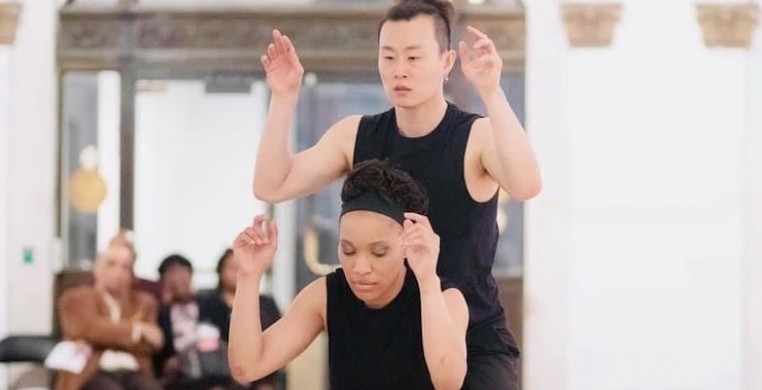She speaks no Korean, he speaks little English, but the language of dance transcends all cultural barriers in the collaboration at the center of the third annual South Chicago Dance Festival. Sponsored by South Chicago Dance Theatre (SCDT), the festival’s mission is to foster cultural diplomacy through movement, a language that needs no translation.
Informal festival events begin Monday, with a 6 p.m. master class and 7 p.m. showing. Students at Walter H. Dyett High School for the Arts and Kenwood High School will have closed audience exchanges of performances by both SCDT and student dance ensembles. A Dance for the Camera Virtual Festival will take place Nov. 11.
How, you may ask, did a Chicago-based dance artist—born and raised in Hyde Park and trained at Hyde Park School of Dance and Western Michigan University—find the likes of Joseph Kim, founding artistic director of Choomna Dance Company of Seoul, South Korea?
Curiosity and a spirit of adventure drive SCDT founding artistic director Kia Smith’s engine. That spirit led her to a quest for dance in corners of the globe not yet recognized by the world of Western concert dance.
With her initial interest in Asia, “I didn’t see much about Korean culture, and I was curious,” she said in a recent phone conversation with See Chicago Dance. Further research led her to Kim and Choomna, the dance company he founded and directs. Smith contacted him. When Kim invited her to visit South Korea, her spirit of adventure took flight.
What she saw when she entered his studio was unlike anything she’d ever encountered before. Smith described Kim’s work as based on Oriental philosophy and the Feldenkrais Method.
The Israeli movement pioneer, Moishe Feldenkrais, developed a somatic practice of body/mind function that addresses the practical relationship between ideation and neurological impulse. His now-classic text, “Awareness Through Movement,” revolutionized the treatment of people suffering from physical and mental disabilities that interfere with efficient, everyday function. Feldenkrais Method is also used in the training of actors, dancers, and musicians to develop awareness of unconscious movement habits that limit artistic range and performance. Movement awareness helps performing artists achieve greater artistic freedom of choice, healthy body mechanics and technical excellence.
Kim and three Choomna dance artists arrived in Chicago this week for their two-week residency. Asked to describe Joseph’s movement, Smith didn’t hesitate. “Fierce!” she said. “He’s strong but seamless, just being still and yet agile. Throwing himself into the air, then to the floor; going for the extremes of stillness and strength.” Speaking of the entire company, she marveled at how “they move their bodies like water. There’s a sense of quietness, fluidity and meditation,” all at the same time.
After watching a video recording of one of their rehearsals, I understood exactly what she meant. It was both still and electrifying, evocative of Noh Theatre in its minimalist attention to the slightest gesture, filling the environment with a collective sense of held breath and expectation. The explosive extremes of movement burst out from total stillness with an almost eerie sense of calm, limbs expanding space beyond the body, pushing range of motion to the extreme, then imploding instantaneously, changing level and shape in quantum dives from air-born to the floor and back again. And all movement clearly was coming from the body’s core with uncanny equanimity.
Kim’s influence on Smith’s artistic development has been profound. “I’m still learning how to work with dancers,” she said, describing how she used to come to rehearsals with set movement phrases, counts and choreographic ideas, model the movement for the dancers, and ask them to copy her. All that changed when she began working with Kim. She felt her own, authentic movement language emerging from the freedom Kim’s improv-based process allowed her, with the creative give and take of all the dancers in the room. “I enjoy the process of making work,” she said, “and I didn’t have that before.”
Her work with Kim eventually led to a 30-minute joint choreographic project between the two companies, which was performed in Seoul two years ago. The piece was to have premiered in Chicago in May of 2020, as part of SCDT’s spring season, but was put on hold due to the COVID-19 pandemic. The work will receive informal showings during the festival week, with a formal premiere in SCDT’s inaugural season at Harris Theater on May 20, 2022.
Smith’s goal for the lifetime of her company is to explore and develop cultural exchanges with 25 groups yet undiscovered by mainstream Western concert dance. Among the candidates are dance companies in Kazakhstan, Mexico and South Africa, among others.
At the same time, Smith is cultivating concert dance repertoire for her versatile company from both local and guest artists whose work spans dance genres of ballet, contemporary, modern dance, and jazz, including her own choreography. Stay tuned for more exciting developments from a bold dance entrepreneur with both the curiosity and spirit to push the boundaries of collaboration and communication through dance.


